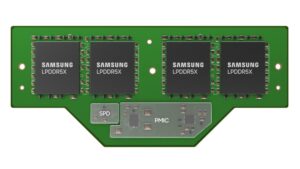Samsung Electronics, a global provider of advanced memory technology, announced that it has developed the industry's first Low Power Compression Attached Memory Module (LPCAMM) form factor, which is expected to transform the DRAM market for PCs and laptops – and potentially even data centers.
Samsung's innovative development of its 7.5 gigabits per second (Gbps) LPCAMM has completed system verification via the Intel platform.
 Historically, PCs and laptops have conventionally used LPDDR DRAM or DDR-based So-DIMMs. Although the LPDDR is compact, it is permanently attached to the motherboard, making it difficult to replace during repairs or upgrades. On the other hand, So-DIMMs can be connected or disconnected easily, but have limitations in performance and other physical features.
Historically, PCs and laptops have conventionally used LPDDR DRAM or DDR-based So-DIMMs. Although the LPDDR is compact, it is permanently attached to the motherboard, making it difficult to replace during repairs or upgrades. On the other hand, So-DIMMs can be connected or disconnected easily, but have limitations in performance and other physical features.
LPCAMM overcomes the shortcomings of both LPDDR and So-DIMMs, meeting the growing demand for more efficient yet compact devices. As a removable module, LPCAMM offers greater flexibility to PC and laptop manufacturers during the production process.
Compared to So-DIMM, LPCAMM takes up to 60% less space on the motherboard. This allows for more efficient use of the devices' internal space, while improving performance by up to 50% and energy efficiency by up to 70%.
“With the growing demand for innovative memory solutions that encompass high performance, low power consumption and manufacturing flexibility in various fields, LPCAMM is expected to gain widespread adoption in PCs, laptops and data centers,” said Yongcheol Bae, vice -executive president of the memory product planning team. at Samsung. “Samsung is committed to actively seeking opportunities to expand the market for LPCAMM solutions and collaborating closely with the industry to explore new applications for their use.”
LPDDR's power-saving features made it an attractive option for servers as it could potentially improve total cost of operation (TCO) efficiency. However, the use of LPDDR can create operational difficulties, such as the need to replace the entire motherboard when upgrading a server's DRAM specifications. LPCAMM offers a solution to these challenges, creating significant potential to become the solution of choice for future data centers and servers.
“The power efficiency and repairability advantages of LPCAMM make this new form factor a game-changer in today’s PC market,” said Dr. Dimitrios Ziakas, vice president of memory and IO technology at Intel. “We are excited to be part of the new standard enabling client PC ecosystem and paving the way for future adoption and innovation across broader market segments.”
LPCAMM is expected to be tested using next-generation systems with large customers this year, and commercialization is planned for 2024.

